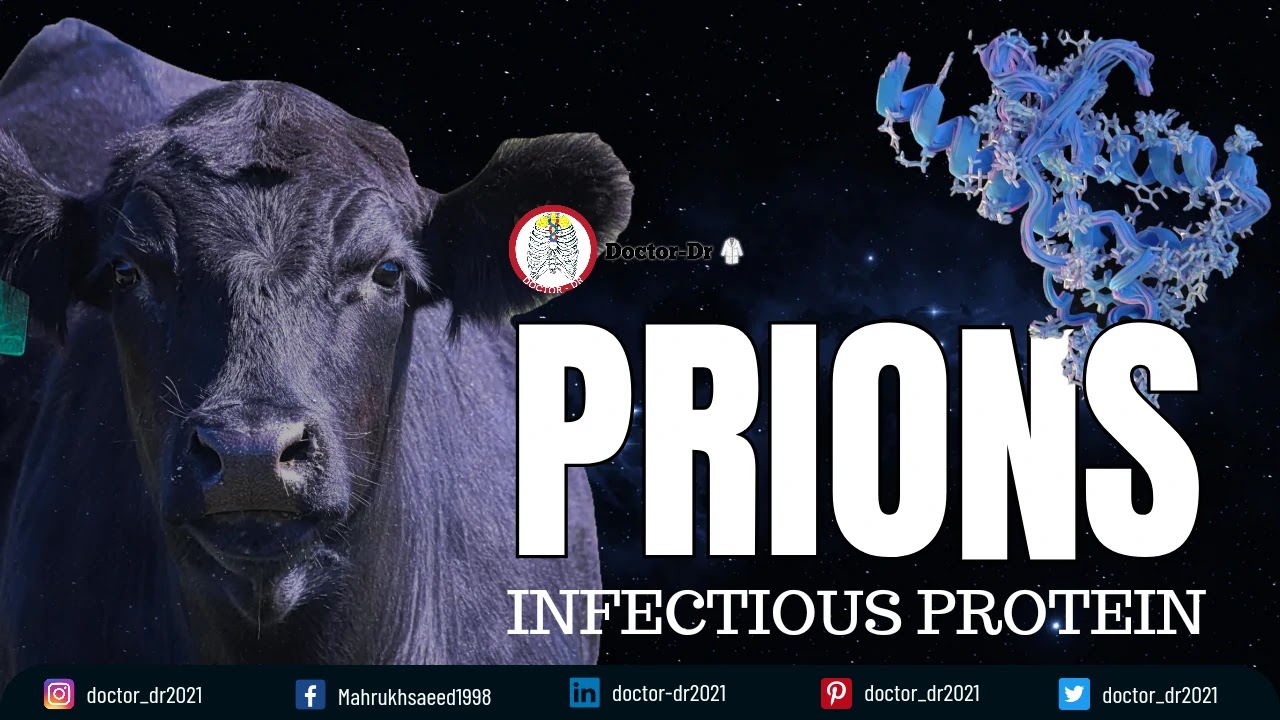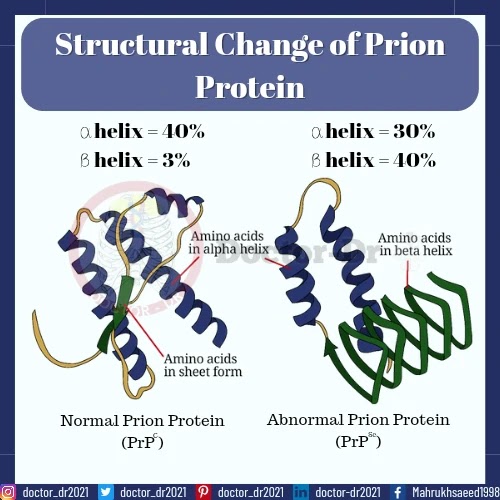Table of Content:
- Introduction
- History
- Structure
- Function
- Diseases Caused
- Types of Prions
- Causes of Prion diseases
- Risk Factors for Prion disease
- Symptoms
Introduction:
- Definition: Prion stands for proteinaceous infectious particles.
- Role in Diseases: Prions are infectious agents linked to various mammalian neurodegenerative diseases, such as Creutzfeldt-Jakob disease.
- Mechanism: Diseases occur due to abnormal folding of brain proteins.
- Hypothesis: Prion hypothesis suggests that the infectious agents causing diseases consist solely of proteins.
- Resilience to Ultraviolet Radiation: Prions are resistant to ultraviolet radiation, explaining their resistance. UV radiation breaks down nucleic acids but has limited impact on proteins.
- Denaturation Sensitivity: Prions are receptive to substances denaturing proteins, contributing to their unique characteristics.
Prion Discovery Timeline:
Late 1960s:
- Research indicated that the agent causing sheep Transmissible Spongiform Encephalopathy (TSE) or scrapie was highly resistant to ultraviolet and ionizing radiation.
- These agents, typically vulnerable to radiation, intrigued scientists due to their resistance.
Unclear Nature of Agents:
- Despite resistance, the nature of these particles remained unclear.
- Scientists proposed various possibilities, including proteins, membrane fragments, small DNA viruses, and polysaccharides.
Hypothesis on Nucleic Acid Independence:
- Some researchers suggested that the agent did not depend on nucleic acid for reproduction.
1982 - Stanley B. Prusiner's Contribution:
- Stanley B. Prusiner from the University of California, San Francisco, published an article in Science in 1982.
- Described the process of purifying the scrapie-causing agent.
- Identified it as a protein and introduced the term "prion."
Term "Prion" Coined:
- Prusiner proposed "prion" to denote a small proteinaceous infectious particle.
- Highlighted its resistance to inactivation by procedures modifying nucleic acids.
Recognition and Nobel Prize:
- Prusiner's groundbreaking discovery led to his recognition and the award of the Nobel Prize in 1997.
Prion Structure:
- Prions are present throughout the body, but disease-causing prions exhibit distinct structural characteristics.
- Some prions show resistance to proteases, enzymes that break down proteins.
Isoforms of Prions:
PrPc (Cellular Prion Protein):
- Found on cell membranes.
- Plays a crucial role in cell signaling and adhesion.
- Ongoing research to uncover additional functions.
PrPsc (Scrapie Prion Protein):
- Disease-causing prion.
- Resistant to proteases.
- Affects the conformation of PrPc, inducing changes.
- Contains more beta sheets compared to alpha helices.
- Forms highly structured amyloid fibers.
- Attracts other free proteins to attach to the ends of these fibers.
Interaction Specifics:
- PrPc and PrPsc binding is selective, relying on similar amino acids.
- Cross-species binding is possible but rare.
Function of Prions:
Normal Cellular Prion Protein (PrPc):
- PrPc is a non-infectious, protective form of the protein.
- Predominantly found on the surface of cells in the central nervous system (CNS) and other bodily tissues.
- The specific role of PrPc is not fully understood, but studies suggest it may play a protective role in cells and aid in responding to oxygen deficiency.
Abnormal Prion Protein (PrPsc):
- The infectious particle is a misfolded form of PrPc, called PrPsc.
- Responsible for progressive neurodegenerative conditions.
Diseases Associated:
- Bovine spongiform encephalopathy (BSE or mad cow disease) in cattle and livestock.
- Creutzfeldt-Jakob disease (CJD) in humans.
Mechanism of Action:
- Prions do not multiply within the host organism but act as templates.
- Induce proteins with normal folding to convert into the abnormal prion form.
Exponential Accumulation:
- Newly formed misfolded proteins serve as templates for the conversion of more normal proteins.
- Leads to an exponential accumulation of prions in CNS tissue.
Formation of Plaques:
- Abnormally folded proteins form plaques in the brain.
- These plaques are believed to cause "entanglement" of neurofibrils and interfere with synapse function.
Diseases Caused by Prions
Nature of Prion Diseases:
- Prions are rare and challenging to transmit.
- Progressive neurodegenerative diseases.
- Lack of cure or treatment, and they develop gradually.
Wide Animal Impact:
- Afflict not only humans but various animals.
- Examples include scrapie in sheep, mad cow disease in cows, chronic wasting disease in deer.
Human Prion Diseases:
- Creutzfeldt-Jakob disease
- Fatal Familial Insomnia
- Kuru disease
Insidious Progression:
- Prions can silently spread in the brain for an extended period without symptoms.
- They begin damaging neurons, and symptoms emerge suddenly.
- Rapid decline in the individual's health.
Fatality and Duration:
- All prion diseases are fatal.
- Varied durations, ranging from a few months to several years.
Unique Characteristics:
- Experimental evidence suggests prions are not typical infectious agents.
- Proposed as "self-replicating proteins."
Types of Prion Diseases:
Prion diseases can be categorized into three types: acquired, sporadic, and genetic.
Acquired Prion Disease:
- Occurs when a person is exposed to the infectious protein.
- Rarely contracted, but examples include kuru disease transmitted through cannibalism in New Guinea.
Genetic Prion Disease:
- Result from genetic transmissions.
- Not necessarily inherited from ancestors but can be caused by mutations in DNA.
Sporadic Prion Disease:
- Cause is not confirmed and is believed to be sporadic.
- Most common form of prion disease to date.
Causes of Prion Diseases
Main Cause of Prion Diseases:
- Prion diseases primarily result from the abnormal folding and clumping of prions in the brain, leading to brain damage.
- Manifestations include memory impairment, personality changes, and movement difficulties.
Nature of Prions:
- Prions are highly dangerous infections.
- Caused by agents already present within the body.
- Typically fatal in nature.
Limited Understanding:
- Despite their severity, much remains unknown about prion diseases.
Risk Factors for Prion Disease:
Genetic Predisposition:
- Individuals with a genetic history related to prion disease are at an increased risk.
Consumption of Infected Meat:
- Eating meat infected by "mad cow disease" raises the risk of prion disease transmission.
Contaminated Medical Procedures:
- Exposure to contaminated medical equipment or contaminated corneas can also be a source of prion disease.
Symptoms of Prion Disease:
- Dementia Development: Progressive cognitive decline leading to dementia.
- Hallucinations: Perceptions of non-existent stimuli, affecting sensory experiences.
- Fatigue: Persistent and profound tiredness or weakness.
- Muscle Stiffening: Rigidity and stiffness in the muscles.
- Confusion: Mental disorientation and lack of clarity.
- Speech Difficulty: Challenges in articulation and communication.



%20Technique%20A%20Comprehensive%20Guide%20to%20Water%20Quality%20Testing%20and%20Microbiological%20Analysis.webp)


~1.webp)

.webp)
